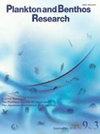Flexible herbivory of the euryhaline mysid Neomysis awatschensis in the microtidal Yura River estuary, central Japan
IF 0.6
4区 生物学
Q4 MARINE & FRESHWATER BIOLOGY
引用次数: 0
Abstract
The euryhaline mysid Neomysis awatschensis occurs widely in estuaries and brackish lakes in Japan. Although N. awatschensis may serve as an essential energy channel to higher trophic levels, its feeding ecology has been studied only in sheltered and desalinated Lake Kasumigaura. To determine major food sources for N. awatschensis, monthly sampling was conducted during the day along the microtidal Yura River estuary from March 2014 to July 2015. Additional sampling was conducted in May 2019 to assess diel vertical migration in relation to feeding. Microscopic examinations revealed that benthic diatoms (e.g. Bacillaria paxillifer and Navicula spp.) dominated in the stomach irrespective of developmental stage, diel cycle, or season. Stable carbon and nitrogen isotope ratios in N. awatschensis and its potential food sources indicated great contributions to the diet of N. awatschensis from benthic microalgae (mainly benthic diatoms) in 2014 and from particulate organic matter (mainly phytoplankton) in 2015. Although N. awatschensis always concentrated close to the bottom in 2019, diel vertical migration might have happened in 2015, when fresh water occupied the whole estuary possibly due to river mouth clogging. Under the stagnant and oligohaline conditions, N. awatschensis could have swum up into the water column and fed on phytoplankton at night in 2015. This hypothesis may resolve the apparent contradiction between the microscopy and stable isotope analysis in 2015. In the Yura River estuary, N. awatschensis feeds primarily on benthic diatoms, although it can utilize phytoplankton flexibly in response to prevailing environmental conditions.日本中部由拉河河口微潮区广盐肉糜鱼的弹性食草性
广海鳗新海鳗广泛分布于日本河口和半咸水湖。尽管N.awatschensis可能是通往更高营养水平的重要能量通道,但其觅食生态仅在有遮蔽和脱盐的Kasumigaura湖进行了研究。为了确定N.awatschensis的主要食物来源,从2014年3月到2015年7月,在尤拉河河口的白天进行了每月采样。2019年5月进行了额外的采样,以评估昼夜垂直迁移与进食的关系。显微镜检查显示,无论发育阶段、昼夜周期或季节如何,底栖硅藻(如巴西利弗贝母和Navicula spp.)在胃中占主导地位。2014年,底栖微藻(主要是底栖硅藻)和2015年,颗粒有机物(主要是浮游植物)对N.awatschensis的饮食做出了巨大贡献。尽管N.awatschensis在2019年总是集中在接近底部的地方,但diel垂直迁移可能发生在2015年,当时淡水可能由于河口堵塞而占据了整个河口。在停滞和少盐的条件下,N.awatschensis本可以在2015年夜间游入水柱,以浮游植物为食。这一假设可能会解决2015年显微镜和稳定同位素分析之间的明显矛盾。在尤拉河河口,N.awatschensis主要以底栖硅藻为食,尽管它可以灵活地利用浮游植物来应对主要的环境条件。
本文章由计算机程序翻译,如有差异,请以英文原文为准。
求助全文
约1分钟内获得全文
求助全文
来源期刊

Plankton & Benthos Research
Agricultural and Biological Sciences-Aquatic Science
CiteScore
1.30
自引率
0.00%
发文量
32
期刊介绍:
Plankton and Benthos Research is a peer-reviewed journal publishing quarterly original papers, reviews and notes dealing with any aspect of the biology and ecology of planktonic and benthic organisms and their interactions with the environment in any aquatic system, and is open to all scientists around the world. Submission of a paper is held to imply that it represents an original contribution not previously published and that it is not being considered elsewhere.
 求助内容:
求助内容: 应助结果提醒方式:
应助结果提醒方式:


